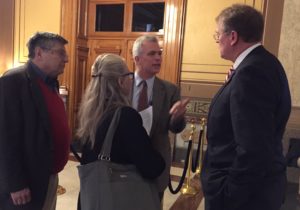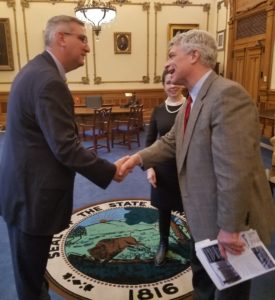By Anne Laker
Forest advocates are moving the meter at the Indiana General Assembly. How, you ask, since the Senate bill to set 30% of state forests from logging did not get a hearing? And an amendment to set aside 10% was defeated in the House.
Here’s why: the Indiana forest bill in the Senate had support from 10 Republicans, was authored by a Republican, and sponsored by two others. In the House, three Republicans spoke in favor of the amendment, and 13 voted for it. Not to mention that both pieces of legislation have the full support of Democrats.
In both cases, the word is that Governor Holcomb put his thumb on the scale. If Rep. Sean Eberhart (R-Shelbyville), the only House Republican to speak against the amendment on the floor, said: “The Governor has authorized me to say that he does not support this policy.” Had this claim not been uttered, who knows how many more Republicans might have voted for it?
So it took backdoor intervention from the Governor to halt progress. This is a governor who has never made a public statement about his position on the logging of Yellowwood, or articulated his own vision for our state forests.
 Last weekend, an IFA member saw Gov. Holcomb walking around Nashville. She boldly approached him about Yellowwood. He said he has just been up in a helicopter with DNR staff. The Governor showed the IFA member pictures taken with his phone (from a major distance). The Governor said there was no old growth forest. The forest advocate stated that she understood that it was farmland in the past, but that the forest has been growing since then. The Governor said there were no 100-year-old trees. He said they were clearing the canopy so smaller growth can get bigger.
Last weekend, an IFA member saw Gov. Holcomb walking around Nashville. She boldly approached him about Yellowwood. He said he has just been up in a helicopter with DNR staff. The Governor showed the IFA member pictures taken with his phone (from a major distance). The Governor said there was no old growth forest. The forest advocate stated that she understood that it was farmland in the past, but that the forest has been growing since then. The Governor said there were no 100-year-old trees. He said they were clearing the canopy so smaller growth can get bigger.
If the Governor is data-driven, as he often claims, he will take interest in IFA’s study of the Yellowwood/Morgan Monroe backcountry. We found 105 trees older than 100 years in the area being logged now. To say the least, forest advocates must continue to educate and engage the Governor.
So then, why are we hopeful? “When you look at the level of bipartisan support in both chambers,” said IFA Executive Director Jeff Stant, “you have to conclude that setting aside some of the state forests from logging is an idea that is gaining traction in the legislature.”
Why is it gaining traction? Two reasons.
 Time and again you’ve responded to the Indiana Forest Alliance’s call to, well, call your lawmakers. Via e-mail, phone and at in-person town hall meetings, you’ve taken the time to contact your senator and representative. Our voices are more audible than ever. Sure, representatives such as Peggy Mayfield and Jim Lucas have state forests in their districts and say they support the DNR. But we’ll only step up our dialogue with lawmakers in this category.
Time and again you’ve responded to the Indiana Forest Alliance’s call to, well, call your lawmakers. Via e-mail, phone and at in-person town hall meetings, you’ve taken the time to contact your senator and representative. Our voices are more audible than ever. Sure, representatives such as Peggy Mayfield and Jim Lucas have state forests in their districts and say they support the DNR. But we’ll only step up our dialogue with lawmakers in this category.
The idea of preserving some of our state forests from logging is not a red or a blue issue. It’s simply a wise, balanced policy. It speaks to the value wild nature has for tourism and for personal enjoyment and solace. Managing a small portion of our forests to be as they were 170 years ago is an exciting goal, one that most Hoosiers from whatever party would undoubtedly support.
The Indiana Forest Alliance is not against all logging. We don’t think that the DNR’s 30 trained foresters are bad people doing things that are 100% bad. Their efforts clearly meet their goal of generating trees to be logged, by supporting more oak and hickory, etc.
We simply question the idea that the single, solitary goal of state forests should be to produce merchantable timber, at the expense of open trails or an aesthetic forest experience or scientific study in unlogged areas. These are the other goals we know to be of value, and there is room for more than one goal. These are the public’s forests, and the public should have a voice in their public purpose.
This is the message we will bring without relent to the Governor, lawmakers, the public, the media with your help.

